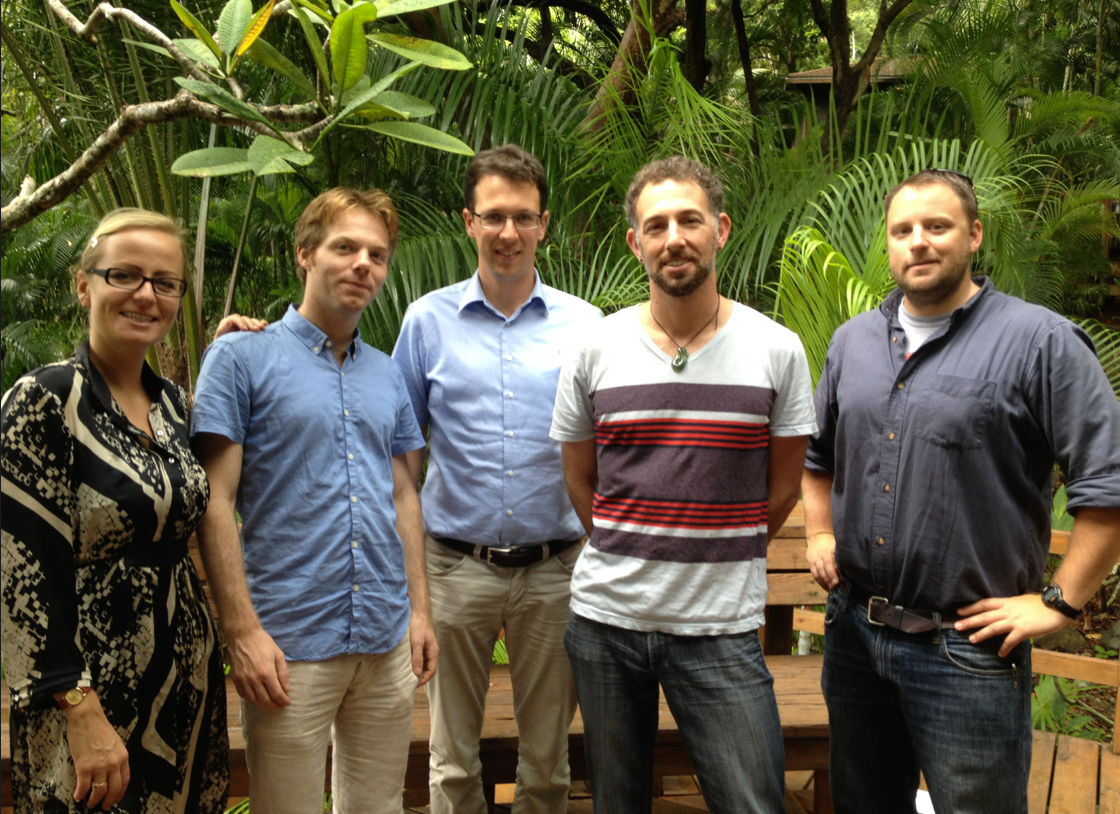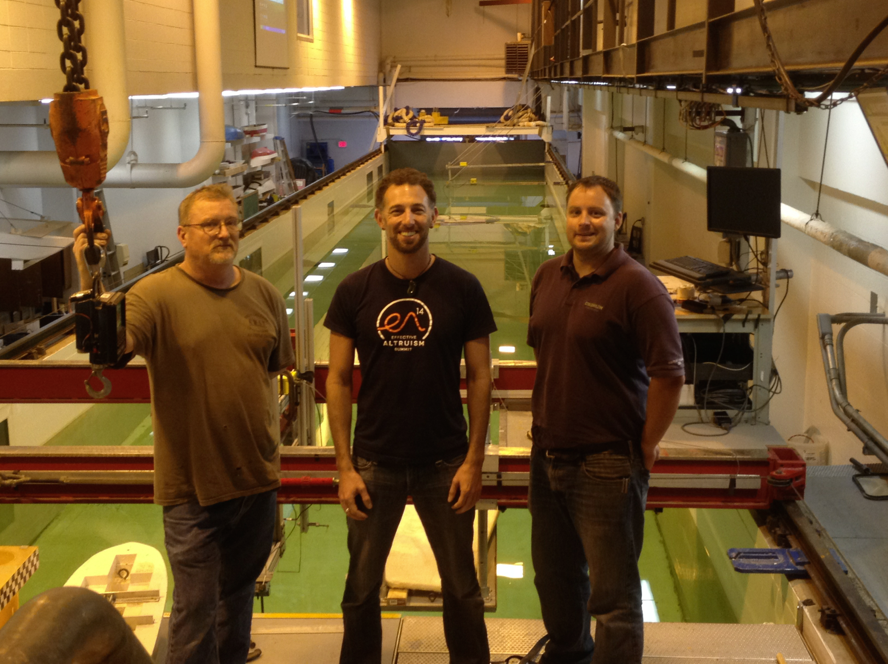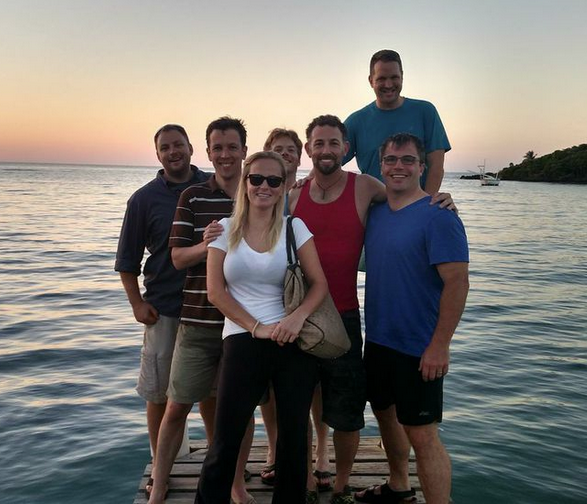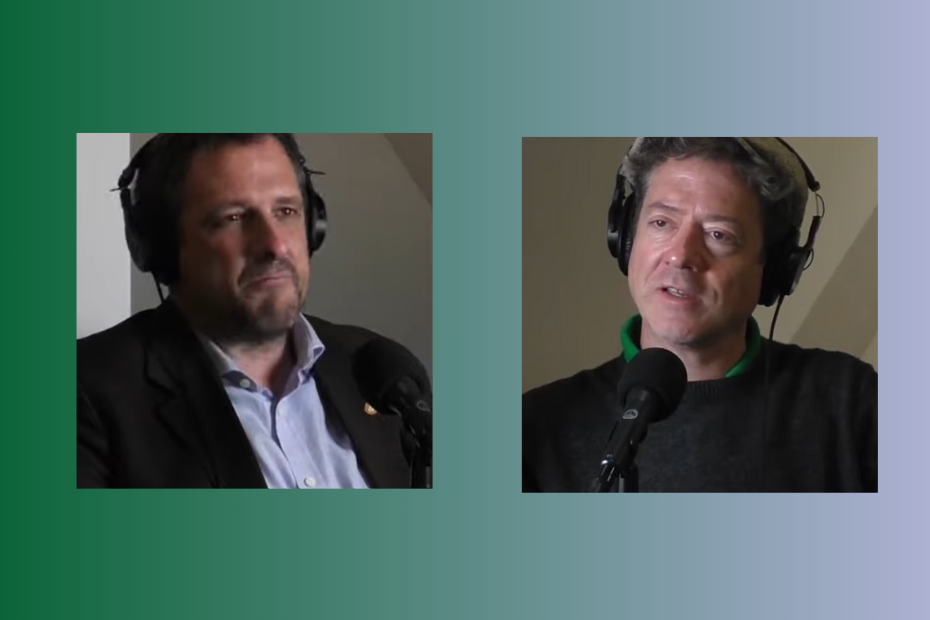Fact-finding & Diplomatic Floating City Project Mission
Last month we took a delegation of architects and engineers to an undisclosed location on a fact-finding and diplomatic mission for our Floating City Project with the intention of locating the first floating city in the sea nearby.
Our diplomatic efforts are going well. We are discussing a scenario that would allow for the Floating City to be stationed within their territorial waters while maintaining the freedoms of substantial political autonomy. I am cautiously optimistic that negotiations will result in a firm agreement with this host nation some time in 2015. However, we will continue to hedge our diplomatic efforts and continue to seek opportunities with other host nations, and make sure that the resources we expend on engineering-related matters are applicable to alternative locations.
Below is a report of the major developments from our recent trip that we are comfortable sharing publicly at this time. For background information, please visit the Floating City Project webpage, and for more detailed information, please review the Floating City Project Report. If you are interested in living aboard the first seastead, please let us know by taking our survey at www.floating-city.org.
Randolph Hencken Executive Director, The Seasteading Institute
P.S., Please support these continuing efforts by making a donation today. As nonprofit think-tank, we are only able to make progress with the generous support of people like yourself.
Executive Highlights
- Met with a congressman, two mayors and a vice mayor, the director and environmental director of the tax-free tourism investment agency, the director of the leading environmental conservation NGO in the area, a shipyard, and a few other tourism- and conservation-oriented parties.
- All of our meetings were positive, with each party genuinely open to us bringing the Floating City Project to their local waters.
- Jobs! – If we bring a development that spurs jobs, we will be welcomed.
- Much of the waters near the location are protected marine areas. Floating developments cannot have a negative impact on the protected coral reefs. Locating the seastead outside the reefs could be a good option to reduce the risk. Although there are a few areas closer to the reef that may be practical without interfering with the marine park.
- The sea conditions a few hundred meters off the coast are suitable for locating the platforms we designed in our Floating City Project report.
- We took a half-day boat trip to scout suitable locations for stationing the floating city.
- We need to revise our financial projections to account for the costs of mooring many tens, hundreds or thousands of meters deep, rather than ten meters as discussed in our original report.
- We believe there could be a market on a seastead for residences, tourism, aquaculture, a business park, a research institute, and a powerplant to sell energy and clean water back to the host nation.
- The national congress of this potential host nation is likely to pass a bill that will offer citizenship to foreigners who invest $500k in the nation; this makes the prospects of locating there more enticing for seasteaders who are interested in internationalizing their citizenship, or giving up their current citizenship.
- Draft a regulatory framework agreement to submit to the national government. Such an agreement would be structured to involve a third party arbitrator to hold the seastead and the host nation to the terms of the agreement. Our draft will be a model that we can shop to other potential host nations. Our “legal braintrust” team has already started on this project. Investigate energy options for the sea-village that could sell energy back to the Island. Two of our advisors are already working on this project. DeltaSync is investigating alternative sustainable options.
- Bart from DeltaSync and Mike from Welwynd Marine will improve the software model DeltaSync created to evaluate wave action on the platforms.
- Mike will test wave action on two platform models placed in a wave tank at the University of New Orleans School of Naval Architecture and Marine Engineering.
- The Institute will run an architecture competition to invite fresh ideas for what could be built on top of the platforms. Possible prize could be an internship at DeltaSync.
- Assuming we get approval from the host nation to bring a seastead to their waters, we will host a conference there to bring investors, potential residents and developers together to prepare them for the opportunities there.
Report from Workweek, Nov 8-15, 2014
Delegation- Karina Czapiewska, Director Project Development, DeltaSync (Netherlands); Project Management and Sustainable Development
- Rutger De Graaf, Managing Director, DeltaSync (Netherlands); Civil Engineer Specialist Floating Urbanization and Sustainability
- Bart Roeffen, Creative Director DeltaSync (Netherlands); Principal Architect, Construction Supervisor
- Michael Capitain, Naval Architect, Welwynd Marine and University of New Orleans (USA)
- Cal Abel, Engineer (Nuclear/Energy), Seasteading Institute Engineering Advisor; Georgia Institute of Technology, formerly US Navy (USA)
- Jason Dorsett, Seasteading Adviser, Supporter, Investor (USA)
- Randolph Hencken, Seasteading Institute Executive Director (USA)

Objectives
Location Selection On a previous trip to the host nation, I was enticed to locate a floating development in one of the bays. However, these areas at this location are often shallow and/or have narrow deep channels to maneuver through. The close proximity to current residents could evoke opposition to our project. Based on wind and wave conditions, our team of engineers believe that our platforms as envisioned would be stable and comfortable in the sea-states found a few hundred meters beyond the reef. We hired a small boat and we were able to identify a few locations several hundred meters from shore where we think we could station the seastead. The ocean in this area quickly drops to thousands of meters deep outside of the reef. This is good for: 1) predictable wave action, 2) being able to locate in deep water where we wouldn’t harm the reef or sea life in shallow water, 3) establishing deep water aquaculture, and 4) ocean thermal energy conversion (OTEC). There are places we could station the platforms at 60-90 meter depths; there are also areas where we would be forced to moor at thousands of meters. The 60-90 meter depth would clearly be better. Furthermore, we discussed opportunities to grow a reef under the floating structure which would bring additional sea life to the surrounding areas. On the boat scouting locations. From left: Cal, Karina, Bart, Rutger, Jason, & Mike.
Financial feasibility
On the boat scouting locations. From left: Cal, Karina, Bart, Rutger, Jason, & Mike.
Financial feasibility
 Randy visited the University of New Orleans’ wave tank last week to follow up on our model testing. From left: UNO Towing Tank Facilities Director George Morrisey, Randy, & Mike.
DeltaSync’s Software Program to Assess Wave Action on a Seastead
DeltaSync’s Intern Morten Slingsby developed a software program that demonstrates how a platform would handle wave action, to predict comfort for those onboard a seastead. The wave data used in the software was drawn from considerably rougher waters than where we plan to station the floating city so that the utmost comfort of residents will be secured. The DeltaSync team reviewed the software with us, which fuels our belief that our floating city could be comfortably stationed in the location we investigating on this trip. Mike pointed out some weaknesses in the software, and DeltaSync will work with Morten to upgrade the program to take into account additional factors.
Platform Construction Capabilities and Costs
We visited a local shipyard. They have a drydock which is too small to build a platform 50 Meters wide. It is plausible we could build platforms in sections and then attach them after they are floated at sea; this is an engineering issue to resolve. A preferable option would be to build on shore, and then move the platforms to sea on top of airbags.
Architects, engineers, environmental engineers, electrical engineers, inventory supervisors, logistics managers, etc. are available in the local population. Labor costs there would be substantially less than in the US. Greyworks are estimated between $200 and $250(US) per square meter. The price of concrete is $100 – $150/square foot, but these prices don’t take it account the fixtures and unique features of a design.
Options to construct elsewhere and tow to the site will need to be evaluated.
Market Case for Development of Floating City
We discussed opportunities and strategies for marketing a seastead to investors, residents, tourists, and business developers. We agree that ultimately our marketing data will define the best path forward, but we understand that there ought to be an anchor business to draw people in and create wealth. The Institute’s ongoing survey research suggests there could be a market for all of the items below that were discussed among the team members on this trip:
Resort – Our shared concern about starting with a resort is that it would compete with other resorts in the area, and it may not lead to full time residency.
Timeshares – This is seen as a path toward full time residency without mandating full time commitment in the initial development.
Powerplant – We discussed a proposal by Cal and other opportunities for sustainable/affordable power generation that could be sold to the host nation.
University/Research Institute – We posit that a university might be interested in establishing a satellite learning program on a floating village.
Tech/Business Incubator – Numerous respondents to the Institute’s survey have expressed interest in business development, particularly software-related projects. Creating a business park would satisfy this market.
Aquaculture – The local population once thrived on fishing, but due to a loss of wild fish stocks and competition from farmed fish elsewhere, the fish business is now much smaller; however, the infrastructure to bring fish to market still exists. The challenge would be to build a program that will not harm or endanger the reef and the native fish.
Environmental and Social Aspects
Possible ways to have a positive environmental impact on the local seas and neighboring nation.Tackle the waste problem. Plastics used by the local population are not recycled, and either end up in the landfill, or as litter, often on the beach or in the water. Providing economic incentives and opportunities for waste collection and recycling can reduce the environmental burden on the reefs.
Only 10% of the sewage water from the land near the site is collected. Coral reefs are vulnerable ecosystems that require a balanced nutrient level. Wastewater collection could improve the water quality, and at the same time, provide the nutrients for aquaculture that would provide jobs.Cal and our legal adviser Mort Taylor have met with an algae biofuel power plant to ascertain options for waste water treatment in conjunction with power production.
Floating structures can provide an ecological habitat, in particular, if we specifically design it for this purpose. A seastead could be a floating ecostructure that actually improves the ecological condition of the surrounding waters and neighboring shores.
A floating development should benefit the local community and provide local jobs. Job creation should to go further than delivering services to a seastead. If the floating platforms are produced locally, the development will create local manufacturing jobs. This opens up opportunity for the host nation to become a seasteading production location for years to come.
Randy visited the University of New Orleans’ wave tank last week to follow up on our model testing. From left: UNO Towing Tank Facilities Director George Morrisey, Randy, & Mike.
DeltaSync’s Software Program to Assess Wave Action on a Seastead
DeltaSync’s Intern Morten Slingsby developed a software program that demonstrates how a platform would handle wave action, to predict comfort for those onboard a seastead. The wave data used in the software was drawn from considerably rougher waters than where we plan to station the floating city so that the utmost comfort of residents will be secured. The DeltaSync team reviewed the software with us, which fuels our belief that our floating city could be comfortably stationed in the location we investigating on this trip. Mike pointed out some weaknesses in the software, and DeltaSync will work with Morten to upgrade the program to take into account additional factors.
Platform Construction Capabilities and Costs
We visited a local shipyard. They have a drydock which is too small to build a platform 50 Meters wide. It is plausible we could build platforms in sections and then attach them after they are floated at sea; this is an engineering issue to resolve. A preferable option would be to build on shore, and then move the platforms to sea on top of airbags.
Architects, engineers, environmental engineers, electrical engineers, inventory supervisors, logistics managers, etc. are available in the local population. Labor costs there would be substantially less than in the US. Greyworks are estimated between $200 and $250(US) per square meter. The price of concrete is $100 – $150/square foot, but these prices don’t take it account the fixtures and unique features of a design.
Options to construct elsewhere and tow to the site will need to be evaluated.
Market Case for Development of Floating City
We discussed opportunities and strategies for marketing a seastead to investors, residents, tourists, and business developers. We agree that ultimately our marketing data will define the best path forward, but we understand that there ought to be an anchor business to draw people in and create wealth. The Institute’s ongoing survey research suggests there could be a market for all of the items below that were discussed among the team members on this trip:
Resort – Our shared concern about starting with a resort is that it would compete with other resorts in the area, and it may not lead to full time residency.
Timeshares – This is seen as a path toward full time residency without mandating full time commitment in the initial development.
Powerplant – We discussed a proposal by Cal and other opportunities for sustainable/affordable power generation that could be sold to the host nation.
University/Research Institute – We posit that a university might be interested in establishing a satellite learning program on a floating village.
Tech/Business Incubator – Numerous respondents to the Institute’s survey have expressed interest in business development, particularly software-related projects. Creating a business park would satisfy this market.
Aquaculture – The local population once thrived on fishing, but due to a loss of wild fish stocks and competition from farmed fish elsewhere, the fish business is now much smaller; however, the infrastructure to bring fish to market still exists. The challenge would be to build a program that will not harm or endanger the reef and the native fish.
Environmental and Social Aspects
Possible ways to have a positive environmental impact on the local seas and neighboring nation.Tackle the waste problem. Plastics used by the local population are not recycled, and either end up in the landfill, or as litter, often on the beach or in the water. Providing economic incentives and opportunities for waste collection and recycling can reduce the environmental burden on the reefs.
Only 10% of the sewage water from the land near the site is collected. Coral reefs are vulnerable ecosystems that require a balanced nutrient level. Wastewater collection could improve the water quality, and at the same time, provide the nutrients for aquaculture that would provide jobs.Cal and our legal adviser Mort Taylor have met with an algae biofuel power plant to ascertain options for waste water treatment in conjunction with power production.
Floating structures can provide an ecological habitat, in particular, if we specifically design it for this purpose. A seastead could be a floating ecostructure that actually improves the ecological condition of the surrounding waters and neighboring shores.
A floating development should benefit the local community and provide local jobs. Job creation should to go further than delivering services to a seastead. If the floating platforms are produced locally, the development will create local manufacturing jobs. This opens up opportunity for the host nation to become a seasteading production location for years to come.
 Our delegation took a well deserved break during a packed week of work. From left: Mike, Rutger, Karina, Bart, Randy, Jason (back) & Cal.
Our delegation took a well deserved break during a packed week of work. From left: Mike, Rutger, Karina, Bart, Randy, Jason (back) & Cal.

This location seems “problematic”, to say the least. Belize, moored close to the reef, would have been much, much better.
Anyway, thanks for the update and best of luck.
Good job. Thank you.
Randy – great that TSI is taking steps to build and test things. My original offer “Bay of Cartagena / Islas Rosario / San Bernardo” – Cartagena Marine Cluster – is still on the table… I will post a more detailed comment here: ( http://concretesubmarine.activeboard.com/t59208581/seasteading-caribbean/ )
> We are discussing a scenario that would allow for the Floating City to be stationed within their territorial waters while maintaining the freedoms of substantial political autonomy.
As a small-time individual donor I can’t say I am very supportive of this collaboration with states, but I hope that you’re negotiating with at least 2 or 3 candidate states so that you can choose the most competitive candidate.
I propose that, when time permits, a state-independent project be considered, initiated and crowdsourced using a crowdsourcing platform based on the bitcoin blockchain.
It could piggyback on the current work, but be state-independent and seen as less risky.
Timesharing and probably everything else would work much better on the blockchain (e.g. see http://www.investopedia.com/articles/investing/121014/medici-blockchain-stock-exchange.asp). Many advantages to such platforms are not mentioned in the article (for example, the ability to run DAOs (https://en.wikipedia.org/wiki/Decentralized_Autonomous_Organization) on top of the bitcoin blockchain.
In 2014. crowdfunding was used to raise tens of millions of dollars in a frictionless, affordable, honest and safe way.
Disclosure: I contribute to Counterparty and own BTC and XCP tokens.